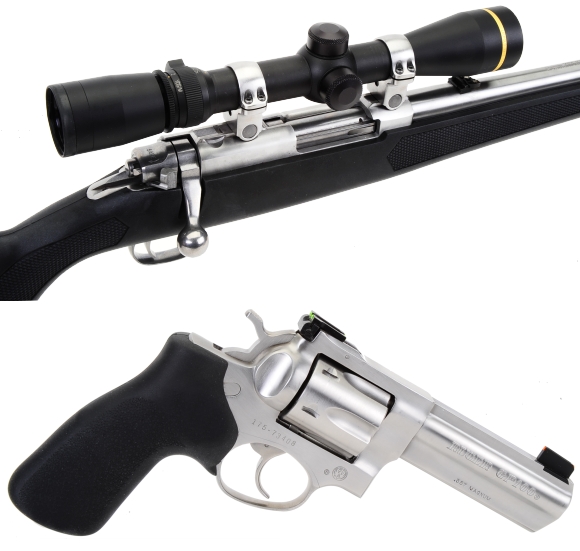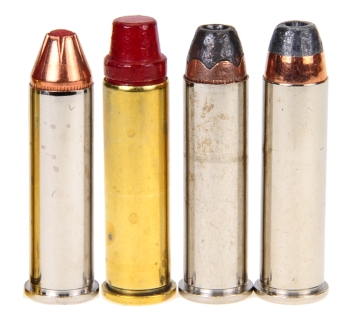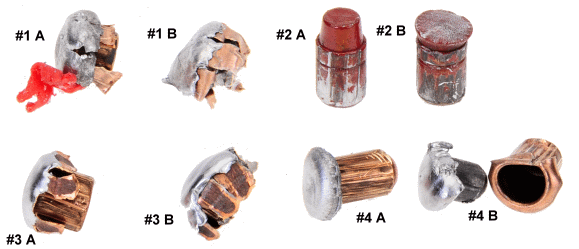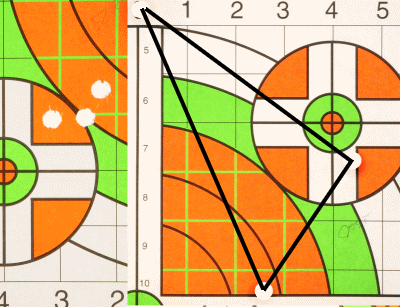How can you tell when you have been spending too much time online? This morning, I picked up a flyer from Home Depot from the kitchen counter. Looking for crab grass killer, I found myself poking at individual product pictures with my index finger, expecting each to enlarge, provide a more detailed description andd present a button that would allow me to place the item into my cart. I find that periodic naps helps to elevate the problem and please don’t poke the pictures….
Reading Companion, Complimentary Firearm Part I, I realized no substantiation of my hypothesis was offered, which got me thinking, “Why do I believe there is value in a rifle/handgun common cartridge combination?!…!. Could this be yet another case of mental, muscle memory and too much exposure to firearm articles of the 1960s?”. Second guessing myself wasn’t troubling, as the question was a good one, but my mind’s voice sounded a lot like James Earl Jones… only with a German accent… Rhineland Palatinate I believe, and that was a bit disconcerting. In any event, the following is me working through an issue and trying to determine why or if companion, complimentary firearms offer something beneficial.

| Specifications | M77/357 | GP100 |
| Type | Carbine | Revolver |
| Manufactured | USA | USA |
| Model # | 7405 | 1705 |
| Caliber | 357 Mag | 357 Mag |
| Action | Bolt | DA/SA |
| Capacity | 5+1 | 6 |
| Barrel Length | 18.5″ | 4.2″ |
| Twist Rate | 1:16″ | 1:18.75″ |
| Overall Length | 38.5″ | 9.50″ |
| Weight | 5.5 Lbs | 2.5 Lbs |
| MSRP | $999.00 | $829.00 |
Both rifle and revolver 357 Magnums were compared in a number of ways: specifications in broad strokes, chronographed velocity, penetration in ballistic gel, and accuracy. The same four common loads were used for all testing and in both firearms.
Boost to muzzle velocity and energy

| 357 Mag Ammunition | Bullet Type |
Bullet Grains |
Mfg. Rated FPS |
4.2″ BBL FPS |
4.2″ BBL Ft-Lbs |
18.5″ BBL FPS |
18.5″ BBL Ft-Lbs |
% FPS Gain |
% Ft-Lbs Gain |
| Hornady Critical Defense | FTX | 125 | 1500 | 1479 | 607 | 1820 | 920 | 23 | 48 |
| Handload – Coated Hard Cast | SWC | 158 | – | 1379 | 667 | 1676 | 986 | 22 | 48 |
| Remington HTP | SJHP | 158 | 1235 | 1367 | 656 | 1699 | 1013 | 24 | 54 |
| Remington HTP | SJHP | 180 | 1145 | 1213 | 588 | 1596 | 1018 | 32 | 74 |
Muzzle velocity and muzzle energy don’t indicate effectiveness on game as game is rarely taken at the end of a barrel. Performance of a common 158 grain factory round was run through the Real Guns exterior ballistics calculator and it came out looking like this.
| Yards | 0 | 10 | 20 | 30 | 40 | 50 | 60 | 70 | 80 | 90 | 100 |
| Revolver FPS | 1367 | 1315 | 1266 | 1222 | 1180 | 1143 | 1110 | 1080 | 1053 | 1028 | 1006 |
| Rifle FPS | 1699 | 1632 | 1567 | 1505 | 1446 | 1390 | 1336 | 1286 | 1240 | 1197 | 1158 |
| FPS Gain | 24% | 24% | 24% | 23% | 23% | 22% | 20% | 19% | 18% | 16% | 15% |
| Revolver Ft.-Lbs | 655 | 606 | 563 | 524 | 489 | 458 | 432 | 409 | 389 | 371 | 355 |
| Rifle Ft.- Lbs | 1013 | 934 | 861 | 795 | 734 | 677 | 626 | 580 | 539 | 502 | 470 |
| Ft.-Lbs Gain | 55% | 54% | 53% | 52% | 50% | 48% | 45% | 42% | 39% | 35% | 32% |
| Revolver Trajectory “ | -1.50 | -0.25 | 0.79 | 1.62 | 2.22 | 2.57 | 2.65 | 2.45 | 1.95 | 1.14 | 0.00 |
| Rifle Trajectory “ | -1.50 | -0.61 | 0.15 | 0.76 | 1.23 | 1.52 | 1.64 | 1.56 | 1.27 | 0.76 | 0.00 |
The longer rifle barrel generated substantially higher velocity all the way out to a hundred yards and, of course, even substantially more kinetic energy. Noticeable during gel block testing, the GP100 would shake the gel blocks, but the rifle shots knocked three blocks in tandem off the bench. Trajectory is flatter for the rifle, but the difference over 100 yards is not significant. The rifle brings the 357 Magnum velocity and energy to a level not attainable with the shorter barrel revolver.
Gel block penetration… very impressive, and a little misleading
| 357 Mag Ammunition | Bullet Weight Grains |
4.2″ BBL Bullet Depth ” |
4.2″ BBL Bullet Diameter “ |
4.2″ Retained Grains |
18.5″ BBL Bullet Depth “ |
18.5″ BBL Bullet Diameter “ |
18.5″ BBL Retained Grains |
| Hornady Critical Defense | 125 | 13.5 | 0.548 | 125.0 | 16″ | 0.667 | 103.3 |
| Handload – Coated Cast | 158 | 29.0 | 0.357 | 157.5 | 23″ | 0.409 | 156.3 |
| Remington HTP | 158 | 20.0 | 0.512 | 117.5 | 17″ | 0.655 | 100.0 |
| Remington HTP | 180 | 19″ | 0.560 | 180.3 | 19″ | 0.590 | 149.2 |
How does a bullet go faster and penetrate less? The velocity increase, in most cases, causes greater bullet expansion, which increase frontal area and braking resistance. So you may not end up with a deeper hole, but you will generally have a significantly larger wound channel. Remember my earlier comment that the rifle shots shocked the gel blocks to a much greater degree. So if you’re hunting gel blocks, or any living target with soft tissue and muscle, they are in serious trouble… or are they?
My testing methodology was found to be lacking
Below, bullets in the order that they appear on the table, top to bottom, A indicated handgun, B indicates carbine.

Gel blocks were positioned as per FBI handgun 10% gel block test procedures, 10′ primarily because I was interested in relative differences between handgun and rifle. Additionally, I am still grappling with using 50 yards or 100 yards as a common, practical difference. For the most part 50 yards is no longer a standard testing distance, but 100 yards remains. The assertion is that 50 yard penetration always falls halfway between 10′ and 100 yards. The first thought might be that distance would diminish penetration, but generally, that should… should not be the case as velocity would diminish, bullet expansion would diminish to some degree and penetration might even increase.
In any event, even at elevated rifle velocity, all but the Remington 180 grain held up. Even in the case of the Remington 180 grain, the shed jacket was parked next to the lead core in the ballistic gel, which suggests the separation occurred at the end of penetration. I like 158 grain and 180 grain jacketed bullets to be shared between revolver and cartridge, but none of those specifically listed above. All excellent handgun defensive ammo, but shedding too much weight and inertia and one that had accuracy problems.

The Ruger Model 77/357 did something for the 357 cartridge that, for most of us, a revolver can not. The carbine put 3 shots into an inch at 100 Yards with Remington 158 grain factory ammo. Both Hornady 125 grain and Remington 180 grain performed essentially the same. My favorite hard cast handload, that routinely shoots under 2″ at 25 yards, would not do better than 6.5″ at 100 yards. Extrapolating from 25 yard revolver performance, I should not have been surprised. So my challenge is to put together a hard cast handload, 158 grains or 180 grains that will equal factory jacketed performance with bullets of the same weights. Why the obsession with the cast bullet? I would like to have a handload that will deliver near MOA accuracy and deliver 20″ or so of penetration.
Interim conclusions
From a weight and form standpoint, the Ruger GP100 and Ruger Model 77/357 suit two different applications. The GP 100 is the weapon of choice on the night stand, while working in the shop, when clearing brush and when walking boundaries. The anticipated maximum outdoor range is 25 yards for dispatching larger varmint and, in a pinch, hunting deer. The very lightweight Model 77/357 would serve for hunting game up to the size of deer and shots out to 100 yards. One more look, Part III

Email Notification